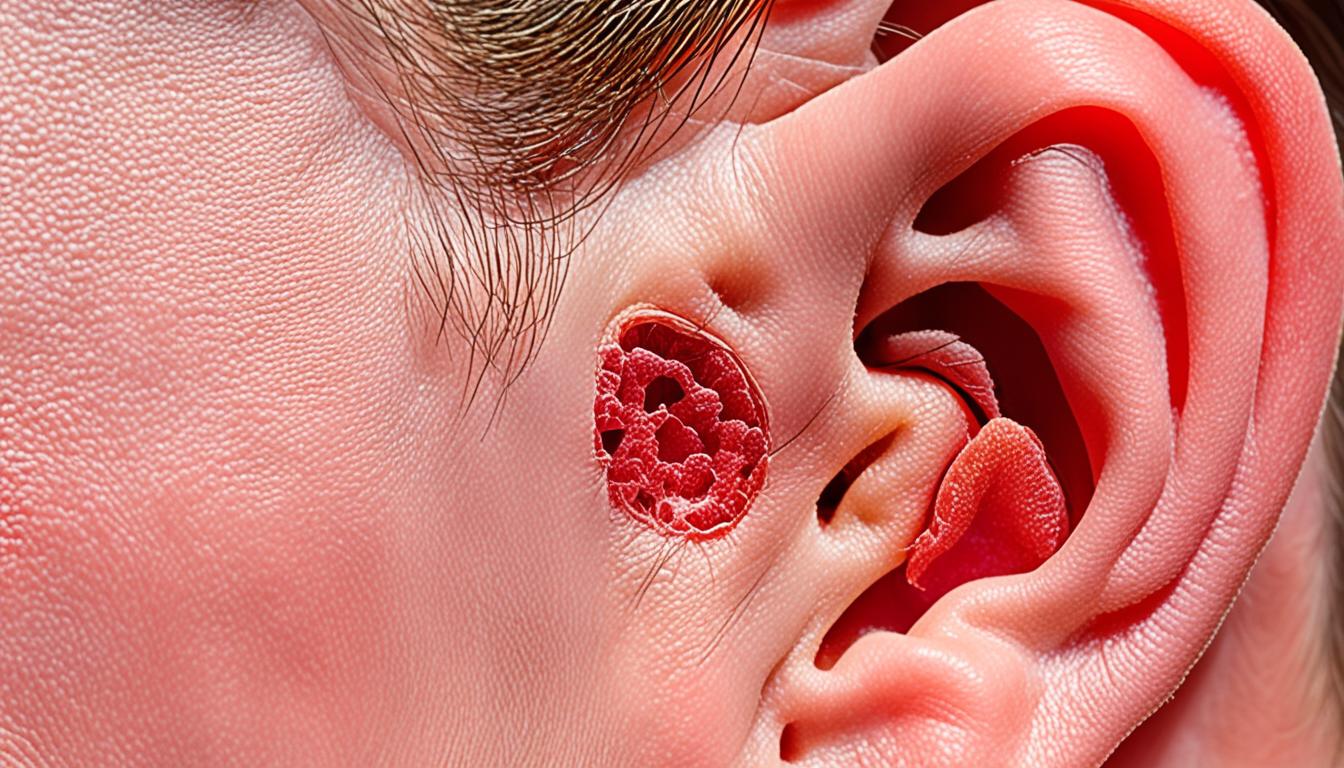A perforated eardrum means there is a hole in the tissue that separates the ears. It can happen from ear infections, pressure changes, ear injuries, or loud noises. If not treated, it can cause problems and discomfort.
Symptoms of a perforated eardrum include sudden hearing loss and ear pain. You might also notice fluid leaking from the ear or feel dizzy. The intensity of these symptoms depends on the size of the hole.
Diagnosis involves a medical professional looking into your ear. They might use a special device called an otoscope. Getting help early is key if you have persistent symptoms.
In many cases, a perforated eardrum can heal without surgery in about 3-6 months. But, if it doesn’t heal, you might face more ear infections or hearing loss. Surgery like eardrum patching is a common treatment for bigger or non-healing holes.
Stem cell therapy is a new and promising way to treat this condition without surgery. It focuses on using stem cells to help the eardrum heal. While more studies are needed, it shows potential as a non-invasive treatment for perforated eardrums.
Key Takeaways:
- A perforated eardrum is a hole or tear in the tissue that separates the outer and middle ear canals.
- Common symptoms include sudden hearing loss, ear pain, fluid leakage from the ear, and temporary hearing loss.
- Causes of a perforated eardrum include ear infections, pressure changes, injury to the eardrum, and loud noises.
- If a perforated eardrum does not heal on its own, it can lead to complications like middle ear infections and hearing loss.
- Stem cell therapy holds promise as an innovative treatment option for perforated eardrums, enhancing tissue regeneration and healing.
Symptoms of a Perforated Eardrum
A perforated eardrum brings about symptoms that are worrisome. Knowing these can help you get the right help quickly.
One sign is sudden hearing loss or trouble hearing. You might feel like sounds are muffled, making it hard to follow conversations.
Ear pain is also a key symptom. It can range from a dull ache to sharp pains. But remember, the pain level doesn’t show how bad the tear is.
Leaking fluid from the ear is another possible sign. This fluid may be clear, bloody, or have a bad smell, showing there’s a hole in the eardrum.
Feeling an itch deep in the ear is common too. It might make your ear feel full and be quite annoying.
Dizziness and feeling off-balance can occur. This can make daily tasks harder to do, which is alarming.
Short-term hearing loss might happen with a perforated eardrum. The hearing usually gets better after the tear heals or if there’s an infection.
If you have any of these signs or think you have a perforated eardrum, it’s time to see a doctor. They can check you out, pinpoint the issue, and suggest the best treatment for you.
Causes and Complications of a Perforated Eardrum
Many things can cause a perforated eardrum. These can lead to problems with hearing and overall ear health. Knowing the causes and risks is key to finding and treating it early.
Causes of Perforated Eardrum
There are several causes like:
- Ear infections: They can lead to pus building up and putting too much pressure on the eardrum.
- Pressure changes: Quick pressure changes, like in air travel, can throw the middle ear off balance.
- Injury to the eardrum: Direct hits to the ear, or putting foreign objects in, can damage the eardrum.
- Sudden loud noises: Very loud noises, like explosions, can be strong enough to pop the eardrum.
Complications of Perforated Eardrum
A perforated eardrum that doesn’t heal in 3-6 months can cause problems. These include:
- Middle ear infections: They become more common with a perforated eardrum and can be hard to treat.
- Hearing loss: It can range from a little to complete, depending on the hole’s size and location.
- Chronic otitis media with cholesteatoma: This is when a hole allows a cyst to form, leading to more serious ear problems.
If you think you have a perforated eardrum or observe any complications, see a doctor right away. Getting the right diagnosis and treatment early is vital for preventing further issues and helping the eardrum heal.
Stem Cell Therapy for Perforated Eardrum (Conclusion)
Stem cell therapy is a new approach for fixing perforated eardrums. It uses the power of stem cells to help tissues heal and regrow.
Studies show good results when stem cell therapy is combined with other treatments. This mix helps improve healing and how well treatments work.
More research is needed to fully know stem cell therapy’s potential. But, it looks very promising as a fix without surgery for big or slow-to-heal holes in the eardrum.
With more studies, stem cell therapy may become a major way to heal and recover from eardrum issues.

